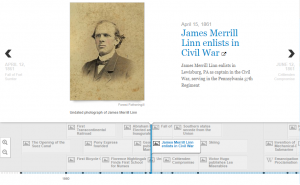TimeMapper is a tool that helps to organize historical figures and events in a chronological order. After you fill in the correct info for your specific event and submit the information, it is then documented in a google doc and is placed into the timeline. In our TimeMapper we created a database of historical events that were happening around the same time that Linn was writing his diary to see what events could relate to James Merrill Linn in the winter of 1862.
Chronology of events is important because if it wasn’t in the correct order the context wouldn’t make sense to the reader and they would have trouble following what was going on. Chronology illustrates the sequence of historical events.
Graphical representation clarifies historical events, because I believe it makes the information more clear and interesting to look at as opposed to just words. It shows the chronological order of events in an organized and easy to follow format.
TimeMapper doesn’t give any representation of the ideas, similarities and connections between different events except for time. In Linn’s narrative the timeline was very helpful in showing the chronological timeframe events were occurring in, but not the connections between the different events.

When I was reading Linn’s diary, I was sometimes confused with the specific events he was talking about during that time period. However, when I saw the timeline comparing his story to the rest of the history, I was able to better understand the context of certain events and have a better perspective of why certain things were occurring. TimeMapper helped me to see where Linn’s diary entries were in relation to history around that time period.

In Grafton’s essay he states how he believes that graphic representation is among the most important tools for organizing information. Grafton states that one of the reasons for the gap in our historical and theoretical understanding of timelines is that people generally consider chronology as a kind of study. He says people see them only as distillations of complex historical narratives and ideas. Chronologies work and that’s pretty much enough for the average reader. But this is a false belief. For example, from the classical period to the renaissance in Europe, chronology was held at a status higher than the study of history itself.After creating a timeline called the Chart of Biography, Priestley reveals that “historical narrative is not linear”. He claimed that a linear timeline does not represent the connections between events and historical figures in a precise way.
 the time when Linn was writing his diary. The creation and study of our completed timeline made me realize a few things. For example, it’s very easy to get wrapped up in a particular set of events. As a result, it can be difficult to recognize, or pay significant mind to, larger events going on around the same time. When reading Linn’s diary, I found myself forgetting that he was writing about events in a small corner of the Civil War. Opening up the scale and comparing his story to the rest of history really put his story into perspective. The scale of a historical graphic really depends on how detailed you make it, represented well by the annals from the 700s in Grafton’s essay.
the time when Linn was writing his diary. The creation and study of our completed timeline made me realize a few things. For example, it’s very easy to get wrapped up in a particular set of events. As a result, it can be difficult to recognize, or pay significant mind to, larger events going on around the same time. When reading Linn’s diary, I found myself forgetting that he was writing about events in a small corner of the Civil War. Opening up the scale and comparing his story to the rest of history really put his story into perspective. The scale of a historical graphic really depends on how detailed you make it, represented well by the annals from the 700s in Grafton’s essay.

